Advertisement

-
Published Date
August 21, 2022This ad was originally published on this date and may contain an offer that is no longer valid. To learn more about this business and its most recent offers, click here.
Ad Text
CELEBRATING 26 YEARS! Welcome to My weekly series! ASK PROFESSIONAL Linda K. Lillie of Sprigs & Twigs Linda K. Lillie has been President of Sprigs & Twigs, Inc. for the last 25 years. She is a graduate of Connecticut College in Botany, an accredited NOFA Organic Land Care Professional, a Connecticut Master Gardener and a national award winning landscape designer for her design and installation projects. Hi Phil, The tree in your photo is called "Tree of Heaven" (Ailanthus altissima). What's shown is a compound leaf with opposite leaflets and no terminal leaflet on the very end. It is not Poison Sumac. Poison Sumac is found in wetland areas and although it has a compound leaf, it is shorter and has a terminal leaflet on the end. Hello Linda - Can you identify these trees? I want to make sure they're not poison sumac. Thanks Phil Tree of Heaven was brought to the US from China in 1748 as a shade tree for ur- ban landscapes. Unfortu- nately, ever since then, it has been shown to be terribly invasive; its rapid growth spells doom for many native species. The Tree of Heaven, which can get 75ft tall, releases chemicals into the soil that inhibit the growth of other plants. The easiest way to identify the Tree of Heaven is to crush a leaf and you will smell a strong, unpleasant odor. There are several trees that look somewhat similar to The Tree of Heaven, i.e., Ash, Black Walnut and Butternut, but Tree of Heaven has compound leaves that are opposite each other on the stem and smooth edges on the leaves (as shown in the picture). In spite of its wonderful sounding name, Tree of Heaven should be removed as soon as you can. You'll have to dig out the whole tree and get all of the roots. If you need help, let me know; Sprigs & Twigs has the equipment and we should be able to help you get rid of it. Sprigs & Twigs EMAIL OR MAIL YOUR QUESTIONS TO: info@sprigsandtwigs.net or Linda Lillie, Sprigs & Twigs Inc, PO Box 245, Gales Ferry, CT 06335 SPRIGS & TWIGS VOTED THE BEST BY DAY READERS EVERY YEAR! CELEBRATING 26 YEARS ! Welcome to My weekly series ! ASK PROFESSIONAL Linda K. Lillie of Sprigs & Twigs Linda K. Lillie has been President of Sprigs & Twigs , Inc. for the last 25 years . She is a graduate of Connecticut College in Botany , an accredited NOFA Organic Land Care Professional , a Connecticut Master Gardener and a national award winning landscape designer for her design and installation projects . Hi Phil , The tree in your photo is called " Tree of Heaven " ( Ailanthus altissima ) . What's shown is a compound leaf with opposite leaflets and no terminal leaflet on the very end . It is not Poison Sumac . Poison Sumac is found in wetland areas and although it has a compound leaf , it is shorter and has a terminal leaflet on the end . Hello Linda - Can you identify these trees ? I want to make sure they're not poison sumac . Thanks Phil Tree of Heaven was brought to the US from China in 1748 as a shade tree for ur ban landscapes . Unfortu nately , ever since then , it has been shown to be terribly invasive ; its rapid growth spells doom for many native species . The Tree of Heaven , which can get 75ft tall , releases chemicals into the soil that inhibit the growth of other plants . The easiest way to identify the Tree of Heaven is to crush a leaf and you will smell a strong , unpleasant odor . There are several trees that look somewhat similar to The Tree of Heaven , i.e. , Ash , Black Walnut and Butternut , but Tree of Heaven has compound leaves that are opposite each other on the stem and smooth edges on the leaves ( as shown in the picture ) . In spite of its wonderful sounding name , Tree of Heaven should be removed as soon as you can . You'll have to dig out the whole tree and get all of the roots . If you need help , let me know ; Sprigs & Twigs has the equipment and we should be able to help you get rid of it . Sprigs & Twigs EMAIL OR MAIL YOUR QUESTIONS TO : info@sprigsandtwigs.net or Linda Lillie , Sprigs & Twigs Inc , PO Box 245 , Gales Ferry , CT 06335 SPRIGS & TWIGS VOTED THE BEST BY DAY READERS EVERY YEAR !
